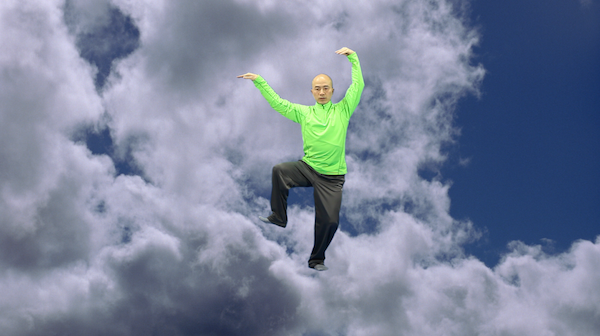
Photo: courtesy of Loui Vuitton Foundation
Xu Zhen New (2014).
Photo: courtesy the Louis Vuitton Foundation.
Repression in China has apparently inspired great courage in the creative class — look no further than Ai Weiwei, today’s pan-cultural poster boy for the triumph of the artistic spirit. But the country has more to offer the landscape of contemporary art than Ai’s notoriously grandiose gestures, and is home to generations of artists who engage their heritage with a nuanced mix of interest, respect, and irony.
The current exhibition at Frank Gehry’s glass-paned Louis Vuitton Foundation in the Bois de Boulogne outside Paris is actually in two parts: “BENTU, Chinese artists in a time of turbulence and transformation” and “A selection of Chinese Works from the Collection.” Until the end of the summer, the foundation has devoted all of its galleries exclusively to Chinese art.
Inaugurating the program in the museum’s lower level is a 12-artist exhibition organized in cooperation with the Ullens Center for Contemporary Art of Beijing. “Bentu,” which means “native soil,” is a show including work in all mediums by artists who are separated by up to 25 years—the oldest, Liu Xiaodong, was born in 1963, and the youngest, Tao Hui, in 1987.
Ai Weiwei Tree (2010).
Photo: courtesy Louis Vuitton Foundation.
In the foyers, Hu Xiangqian’s video The Woman in Front of the Camera (2015) sets up the complex dynamic between collective and individual influences that recur throughout the show. In it, a middle aged woman dances by herself in a Beijing park, smiling radiantly and waving a pink scarf as by-passers observe, gawk, or carry on with their day.
Although she appears to be isolated in her own ecstasy, her world continues to intersect with the space of others: it’s a cinematic Ven diagram of private and public spheres, functioning as a paean to the realities of contemporary city life.
Hu Xiangqian The Woman in Front of the camera (2015).
Photo: courtesy Louis Vuitton Foundation.
Inside the first gallery, prankster Xu Chen has contributed the show’s only outright reference to Western art. Titled The Soldier of Marathon Announcing Victory, A Wounded Galatian (2014), this tongue-in-cheek sculptural installation pairs two classical sculptures from the Louvre in a game of Leap Frog, repeated five times along a pedestal. Chen, who is a curator, gallery owner and business man as well as an artist, is known for provocative installations and performances that explore cultural clichés and question the idea of an artwork’s originality, instead suggesting the prevalence of production lines and outsourcing.
“So much Chinese art has been discussed in the past in terms of its relation to Western precedents and other contemporaries,” Laurence Bosse, who curated the show with Phil Tinari, told artnet News at the press preview. “I thought it was important that the works in ‘Bentu’ resist those kinds of comparisons; it’s kind of nice to start with a strong piece like Chen’s that gets it of the way in this very light, flippant way.”
Wry, self-referential and occasionally self-deprecating humor runs throughout the exhibition. In Hu Xiangqian’s video Speech at the Edge of the World (2013) the artist takes the podium at his former high school, but his inspirational pep-talk uses rhetoric that evokes generic power-speak common in dime-store motivational manuals—or Communist propaganda. Standing awkwardly in white-and-blue uniforms, the students stare blankly ahead as he declares, “Time flies; it is never too late to start!”
Xu Zhen Physique of Consciousness (2011).
Photo: courtesy of Loui Vuitton Foundation.
The paintings in the show are particularly compelling. Liu Wei’s Liberation no. 16 (2014), is an abstract oil painting derived from digitally-rendered graphics. Reversing the trajectory of societal progression — beginning with advanced technology and regressing back to a manual technique, in this case oil painting — he visually manifests the hypocrisy of those with nostalgia for a simpler past who are unwilling to renounce modern tools.
Liu Xiaodong, meanwhile, engages the history of Chinese Realism with his 2010 “Hometown Boy” series. Painted from life in his natal town of Jincheng, canvases like My Egypt and Bent Rip inject scenes that might evoke the country’s pastoral past with symbols of contemporary life that ultimately disrupt any idyllic visions. Bare-chested farmers stand in rice fields, consulting an X-ray; a peasant takes a rest against a ruined stone wall, his feet strapped into hi-tech sporty sandals.
“This is the first time that all the exhibition spaces are given to one culture and one country,” artistic director of the foundation Suzanne Pagé said. “It is astonishing to explore the immense difference in contemporary Chinese art, both in terms of how these artists differ from their contemporaries, and how they differ from one another.”
“BENTU, Chinese artists in a time of turbulence and transformation” is on view until May 2; “A selection of Chinese Works from the Collection” is on view until August 29 at the Louis Vuitton Foundation in Paris.